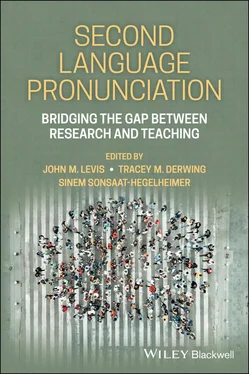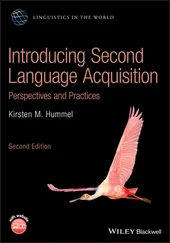Second Language Pronunciation
Здесь есть возможность читать онлайн «Second Language Pronunciation» — ознакомительный отрывок электронной книги совершенно бесплатно, а после прочтения отрывка купить полную версию. В некоторых случаях можно слушать аудио, скачать через торрент в формате fb2 и присутствует краткое содержание. Жанр: unrecognised, на английском языке. Описание произведения, (предисловие) а так же отзывы посетителей доступны на портале библиотеки ЛибКат.
- Название:Second Language Pronunciation
- Автор:
- Жанр:
- Год:неизвестен
- ISBN:нет данных
- Рейтинг книги:5 / 5. Голосов: 1
-
Избранное:Добавить в избранное
- Отзывы:
-
Ваша оценка:
- 100
- 1
- 2
- 3
- 4
- 5
Second Language Pronunciation: краткое содержание, описание и аннотация
Предлагаем к чтению аннотацию, описание, краткое содержание или предисловие (зависит от того, что написал сам автор книги «Second Language Pronunciation»). Если вы не нашли необходимую информацию о книге — напишите в комментариях, мы постараемся отыскать её.
Second Language Pronunciation: Bridging the Gap Between Research and Teaching
Second Language Pronunciation: Bridging the Gap Between Research and Teaching
Second Language Pronunciation — читать онлайн ознакомительный отрывок
Ниже представлен текст книги, разбитый по страницам. Система сохранения места последней прочитанной страницы, позволяет с удобством читать онлайн бесплатно книгу «Second Language Pronunciation», без необходимости каждый раз заново искать на чём Вы остановились. Поставьте закладку, и сможете в любой момент перейти на страницу, на которой закончили чтение.
Интервал:
Закладка:
The parallel (or non-communicative) approach to integration means that pronunciation is planned as part of instruction but it is not connected in any obvious way to other language goals. For example, phonics-oriented instruction may show students how to predict sound from spelling patterns, but this is done within a parallel section of course instruction rather than incorporated into reading instruction.
The communicative approach not only takes into account the inclusion of pronunciation into instruction but also ensures that pronunciation features are implanted into communicative tasks. For example, in teaching rhythmic adjustments to connected speech, transcripts from listening activities would be used to demonstrate how vowel reduction, linking, and other aspects of connected speech work within the already planned activity.
Researching Pronunciation Integration: Moving the Field Forward
We know that teaching pronunciation in any form almost invariably leads to improvement in accuracy (Lee et al., 2015; Thomson & Derwing, 2015), especially in the short term, but we have little knowledge of how different ways of teaching pronunciation result in different outcomes. This is especially true in documenting the effects of approaches that integrate pronunciation into the classroom, both for specific features (e.g., Levis & Muller Levis, 2018) and for more general approaches that prioritize pronunciation as part of global speaking and listening skills (Derwing et al., 1998; Zhang & Yuan, 2020). Effectively integrating pronunciation with other areas of language instruction may serve as a “value-added” factor in language instruction (Pennington & Rogerson-Revell, 2019); that is, it may serve to show learners that other L2 language skills improve more when integrated with improved pronunciation skills. This section will describe possible ways to research the integration of pronunciation so that we better understand how integrating pronunciation affects teacher confidence, student communicative success, and effective materials development. Such research may show that pronunciation integration leads to better comprehensibility and intelligibility, that it leads to equal or greater improvement than teaching pronunciation alone, and it may demonstrate the best ways to integrate pronunciation.
There are few studies on the effectiveness of integrating pronunciation with other aspects of language teaching. This means that this is a largely unexplored area with great importance for the overall effectiveness of classroom language teaching. Like all instructional studies, ensuring that instructional contexts are as similar as possible is a challenging task. The ideas in Table 2.2all have in common two (or more) classes in which the instructional focus differs in how pronunciation is addressed. Details of effective research practices are not addressed, but they can be found in Munro and Derwing (2020).
Table 2.2 Ideas for researching pronunciation integration.
| Research Goals | Class 1 | Class 2 |
|---|---|---|
| What happens when teaching the same pronunciation features in different ways? | Pronunciation features (PF) taught as stand-alone features in parallel to Listening/Speaking (L/S) instruction | Same PFs integrated so the features are explicitly connected to L/S instruction |
| Is there a difference between reactive and proactive pronunciation instruction? | No focus on PF outside of what teachers normally do (with particular features targeted) | PFs proactively integrated into L/S instruction (with particular features targeted) |
| Does the type of integration result in different outcomes? | Integration of PFs is done as an add-on, with work on particular PFs as another activity among many (as in integrated skills textbooks). | Integration of particular PFs is fully integrated into other parts of teaching. |
| Is the teaching of PFs relevant to the overall topic more effective than teaching irrelevant PFs? | Teach PFs that are largely irrelevant for topic (e.g., vowels for spoken fluency) | Teach PFs that are relevant to topic (e.g., thought groups for spoken fluency) |
| Does the integration of PFs into a reading class lead to better reading outcomes (e.g., for phonemic awareness)? | Teach reading without addressing PFs | Teach reading while addressing PFs |
| Does the intensity of integration make a difference in outcomes? | Integrate a modest amount each day during the term. | Integrate intensively during the first several weeks, then as needed. |
| What is the effect of explanation vs. practice? | Integrate with explanation only in class. Practice via optional homework. (Variant: Explain with optional homework) | Integrate with explanations and with class practice. (Variant: Explain with required homework) |
| What is the effect of integrating different PFs into instruction? | Integrate one or more PFs or aspects of PFs (e.g., Prominence signaling New information) | Integrate other PFs (e.g., Prominence signaling contrasts) |
Pedagogical Implications – Vignettes and Textbook Connections
In this section, we examine two ways of integrating pronunciation into classes focused primarily on other skills. We do this first through the use of vignettes, in which teachers create their own non-textbook focused plan and second, through examples of how to connect pronunciation skills to published textbook materials. These two approaches provide distinct challenges. In the vignettes, teachers have tremendous flexibility about what is included in a lesson, but when following the pedagogy provided by textbooks (which an instructor often has not chosen), pronunciation connections often must be made by teachers without assistance from the textbook or teacher’s guide. In our examples, we have developed two vignettes showing how pronunciation can be integrated into different types of ABE classes. In the first vignette, we look at a literacy-level class, where basic literacy skills and vocabulary lessons are taught with a workplace focus. Vignette 2 involves a pre-CNA (Certified Nursing Assistant) class with high intermediate and advanced English learners. In addition, we look at two examples of published materials (one for lower-level classes and one for higher level) to show where pronunciation can be relevant to other skills even when it is not included by the textbook authors.
Vignette 1
In this workplace-focused literacy-level class, the learners are newly arrived refugees from Southeast Asia, with native speakers of Burmese, Karen, Karenni, and Nepali. Approximately half are literate in their native languages that use non-Roman alphabets, and the other half have limited or no literacy skills. All learners have limited speaking and listening skills in English.
To determine the most prominent pronunciation challenges for this group of learners, the teacher carried out a simple diagnostic to analyze the pronunciation of various features in English, and to prioritize them in order of importance. After completing the diagnostic, the teacher determines that many learners do not produce consonant sounds at the ends of words, and that many speak very softly with minimal articulation of word and sentence stress. Therefore, the teacher incorporates activities focusing on these areas into the lesson planning ( Table 2.3), using the predetermined lesson content: developing vocabulary to report a workplace injury.
Table 2.3 Lesson plan for final sounds, spelling-pronunciation correspondence and sentence stress in Vignette 1.
| Activity with Integrated Pronunciation | Literacy Skills | Pronunciation Element |
|---|---|---|
| The teacher says each word as learners count the sounds on their fingers, segmenting each word into individual phonemes so that learners can clearly hear and count them (e.g., back has three sounds). The teacher distributes cards divided in three sections. Learners place a marker on the section where they hear the target sound (e.g., for Where is the /p/ in hip? the marker is placed on the final section. Where is the /h/ in hip? the marker is placed on the first section. Where is the / ɪ / in hip? the marker is placed in the middle section). | Phonemic Awareness: Phoneme Segmentation Phonemic Awareness: Phoneme Isolation | Perception development of all sounds in target vocabulary with teacher feedback Auditory and Kinesthetic |
| The teacher says a body part and the learners write the last sound on mini-whiteboards, and hold it up for the teacher to see (e.g., for hand , the learners write d). The teacher engages learners in spelling the words on their mini-whiteboards, starting with the final sound and working forward. | Phonemic Awareness: Phoneme Isolation and Phonics and Spelling | Perception development of final sounds in target words with teacher feedback Auditory and Visual |
| The teacher introduces the question, “What’s wrong?” and the response, “I hurt my _____.” The teacher models how to emphasize the word hurt and the target body part, and minimize the words I and my , first by having the learners clap on the stressed words, then by having the them gesture on the emphasized words. The teacher then asks the class, “What’s wrong?” and holds up a picture. The class provides the prompted response; the teacher gives feedback as needed. | Vocabulary development and speaking fluency | Controlled production and practice of sentence stress with teacher feedback Kinesthetic, Auditory and Visual |
| Each learner receives a picture of a body part. Learners mingle and pair up; the first learner asks, “What’s wrong?” The second learner responds, “I hurt my ___,” saying the body part word indicated in their picture. The learners then switch roles. After the dialogue has been repeated, the learners trade pictures, then find a new partner. | Speaking and listening fluency | Extension of sentence stress production Auditory and Visual |
Opening the Lesson: The teacher introduces parts of the body using pictures, then leads the class through a Total Physical Response (TPR) activity; the teacher issues commands (e.g., Point to your leg. Point to your head .) and the learners listen and follow the instructions. The teacher then moves to activities that build both perception and production of final consonants in target vocabulary, with the repetition and the immediate feedback from the teacher and classmates helping learners commit accurate phonological representations of the words to their long-term memory. Additionally, the perception activities help learners develop their spelling ability for later writing activities; when asked to “sound it out,” they are more acutely aware that words are made up of individual sounds that can be pulled apart to discover the spelling of a word. Most activities in the lesson do not incorporate reading or writing, instead providing multiple auditory and kinesthetic opportunities to practice target vocabulary. This allows learners to focus on perception and production of the vocabulary without interference from written text.
Читать дальшеИнтервал:
Закладка:
Похожие книги на «Second Language Pronunciation»
Представляем Вашему вниманию похожие книги на «Second Language Pronunciation» списком для выбора. Мы отобрали схожую по названию и смыслу литературу в надежде предоставить читателям больше вариантов отыскать новые, интересные, ещё непрочитанные произведения.
Обсуждение, отзывы о книге «Second Language Pronunciation» и просто собственные мнения читателей. Оставьте ваши комментарии, напишите, что Вы думаете о произведении, его смысле или главных героях. Укажите что конкретно понравилось, а что нет, и почему Вы так считаете.












